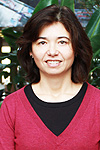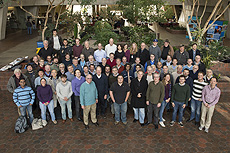Mu2e moves forward with new collaborations, new deputy project manager
 |
|
Julie Whitmore
|
The new year brings new additions to Mu2e, an experiment at Fermilab that aims to detect the direct conversion of a muon into an electron in search of physics beyond the Standard Model. Along with the appointment of a new deputy project manager, seven institutions have joined the effort.
Mu2e scientists are currently at the stage of finalizing experimental design. With the strong recommendation from the Particle Physics Project Prioritization Panel (P5) in 2014, the project is now moving forward through the final clearance stages to commence construction and prepare for data taking in 2020.
Since being appointed deputy project manager in October, Julie Whitmore has been busy in her new role. With the upcoming construction of the building, magnets and detectors, a major part of her role involves ensuring technical issues are managed.
"It's like running a marathon," Whitmore said. "I can't just look at the finish line because there are so many steps along the way."
Externally, the Mu2e project has gained seven new institutional collaborators both nationally and internationally. A number of universities are represented: the University of Louisville, University of Minnesota, University of South Alabama, Yale University and the Novosibirsk State University in Russia. In addition, two laboratories, the Genoa, Italy, branch of the National Institute of Nuclear Physics and Argonne National Laboratory, have joined the Mu2e collaboration, bringing the total number of collaborating institutions to 32.
According to Doug Glenzinski, who is co-spokesperson of Mu2e along with Jim Miller, the new collaborators were motivated by excitement about Mu2e's goals and the positive results from the P5 report.
In order to detect the rare transformation from muon to electron without the emission of neutrinos, researchers require a sophisticated apparatus capable of precision measurements. The new groups offer valuable resources in the form of expertise in areas such as magnet technology and flavor physics.
"These new groups bring in additional experience, wisdom and expertise," Glenzinski said. "It puts us in a stronger position to ensure that the apparatus we decide to build will let us do the physics we want to do."
There is still much to be done before data collection begins, but many heads are coming together with the promise of exciting results at the end of the road.
"This is a huge jump," said Dan Cronin-Hennessy, a new collaborator from the University of Minnesota. "The measurements of Mu2e are the golden path to new physics."
—Diana Kwon
 |
| The Mu2e collaboration has recently expanded to include seven more institutions. The collaboration now comprises 185 members, some of them shown in this photo. Photo: Reidar Hahn |
|